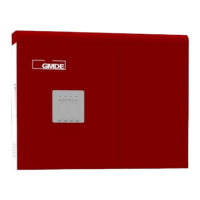What to do if GMDE Inverter shows error E01?
- AAnna BrownAug 2, 2025
If the error E01 occurs repeatedly on your GMDE Inverter, contact the service.

What to do if GMDE Inverter shows error E01?
If the error E01 occurs repeatedly on your GMDE Inverter, contact the service.
What to do if GMDE Inverter shows error E02?
If your GMDE Inverter displays error E02, wait until the controller has re-stabilized.
| Battery Capacity | 4.8kWh |
|---|---|
| Nominal Voltage | 48V |
| Max Discharge Current | 50A |
| Max Charge Current | 50A |
| Operating Temperature | -10°C to 50°C |
| Rated Power | 2400W |
| Cycle Life | 6000 cycles |
| Communication Interface | RS485, CAN |
| Protection | Overcurrent, Short circuit, Over temperature |
Guidance on navigating and understanding the manual's structure and content.
General safety guidelines, including warning symbols and their meanings, and specific safety rules.
Crucial safety advice covering installation, operation, maintenance, and modification of the device.
Instructions for proper disposal of the device and exclusion of liability clauses for misuse or damage.
Explanation of the GBESS 2.4_4.8KWH system and its designed purpose.
Visual representation and explanation of how system components are interconnected.
Procedures for unpacking all components and checking their packing lists.
Step-by-step instructions for physically mounting the inverter, battery cabinet, and energy meter.
Detailed guides for connecting power and communication lines, including specific system configurations.
Explanation of the LCD screen layout, navigation buttons, indication lights, and display definitions.
Detailed guide to setting various operational parameters via the LCD, including time, battery, currents, modes, and certifications.
Steps for configuring Wi-Fi, connecting to the network, and registering on the GMDE portal for remote monitoring.
Steps for initial system settings and the startup sequence for the inverter and battery.
Explanation of On-grid (Self-use, Time of Use) and Off-grid operational modes.
Guidelines for safe shutdown, maintenance tasks, and long-term storage of the system.
Critical safety measures to be taken when diagnosing and resolving system issues.
A list of fault messages, their meanings, and recommended actions for troubleshooting.
Steps for acknowledging faults and information on contacting technical service for assistance.